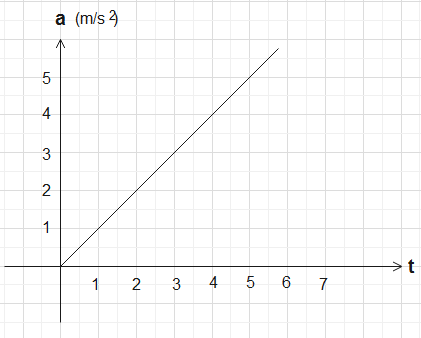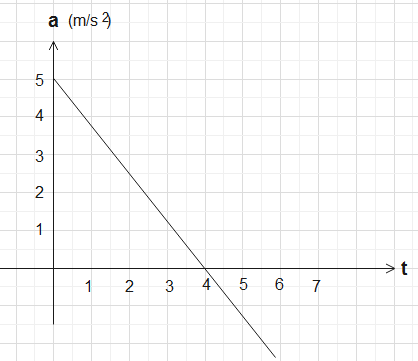
The area under acceleration-time graph represents-
(A). displacement
(B). velocity
(C). change in velocity
(D). distance travelled
Answer
555k+ views
Hint: Acceleration is the rate of change of velocity of a body. It is also the double derivative of displacement and single derivative of velocity. Acceleration is directly proportional to velocity and inversely proportional to time. The area of a graph is the product of its dimensions. According to Newton’s second law of motion, a body undergoes acceleration when there is force acting on it.
Complete answer:


The change in velocity per unit time is called acceleration. Its SI unit is $m\,{{s}^{-2}}$. The formula for acceleration is-
$\text{acceleration = }\dfrac{\text{change}\,\text{in}\,\text{velocity}}{\text{time}}$
From the above eq, $\text{acceleration}\times \text{time}=\text{ change in velocity}$ - (1)
Area under the curve in the graphs above is given by-
$\text{Area}=\text{ acceleration x time}$ - (2)
From eq (1) and eq (2), we get,
Area= change in velocity.
Therefore, the area covered under the curve of acceleration- time graph is change in velocity, so the correct option is (C).
Additional Information:
The slope of the graph is given by $\tan \theta $(here,$\theta $ is the angle made by the graph with the positive direction of x-axis). Slope between two points gives us the change in acceleration for a given period of time between those two points. The higher the slope, the more change in acceleration for a given time period. Slope is also given by the tangent drawn to a graph.
Note:
Area of a graph is the two dimensional space covered under it. It is calculated as the product of dimensions. In a graph, the physical quantities along the x-axis and y-axis are its dimensions. According to the second law of motion, acceleration is due to the application of force.
Complete answer:


The change in velocity per unit time is called acceleration. Its SI unit is $m\,{{s}^{-2}}$. The formula for acceleration is-
$\text{acceleration = }\dfrac{\text{change}\,\text{in}\,\text{velocity}}{\text{time}}$
From the above eq, $\text{acceleration}\times \text{time}=\text{ change in velocity}$ - (1)
Area under the curve in the graphs above is given by-
$\text{Area}=\text{ acceleration x time}$ - (2)
From eq (1) and eq (2), we get,
Area= change in velocity.
Therefore, the area covered under the curve of acceleration- time graph is change in velocity, so the correct option is (C).
Additional Information:
The slope of the graph is given by $\tan \theta $(here,$\theta $ is the angle made by the graph with the positive direction of x-axis). Slope between two points gives us the change in acceleration for a given period of time between those two points. The higher the slope, the more change in acceleration for a given time period. Slope is also given by the tangent drawn to a graph.
Note:
Area of a graph is the two dimensional space covered under it. It is calculated as the product of dimensions. In a graph, the physical quantities along the x-axis and y-axis are its dimensions. According to the second law of motion, acceleration is due to the application of force.
Recently Updated Pages
Master Class 12 English: Engaging Questions & Answers for Success

Master Class 12 Business Studies: Engaging Questions & Answers for Success

Master Class 12 Economics: Engaging Questions & Answers for Success

Master Class 12 Social Science: Engaging Questions & Answers for Success

Master Class 12 Maths: Engaging Questions & Answers for Success

Master Class 12 Chemistry: Engaging Questions & Answers for Success

Trending doubts
What are the major means of transport Explain each class 12 social science CBSE

Which are the Top 10 Largest Countries of the World?

Draw a labelled sketch of the human eye class 12 physics CBSE

Explain sex determination in humans with line diag class 12 biology CBSE

The pH of the pancreatic juice is A 64 B 86 C 120 D class 12 biology CBSE

Explain sex determination in humans with the help of class 12 biology CBSE




